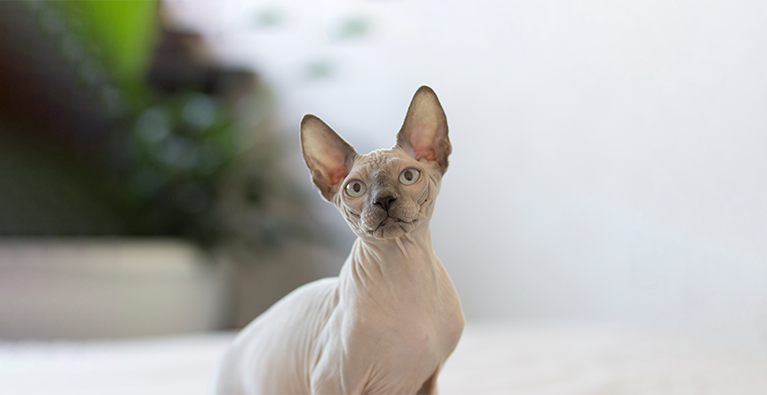Sphynx cat
No other breeds are as polarising as hairless cats, which include the Canadian Sphynx. Some people adore them, while others do not like the look of them at all. However, when it comes to their inner qualities, everyone seems to be in agreement.
Profile of the Sphynx cat
- Size medium
- Weight female: approx. 4 kg, male: approx. 5 kg
- Origin Canada
- Build medium length, muscular
- Length of fur hairless, short downy fur
- Colour of fur all colours
- Grooming easy
- Behaviour affectionate, playful
- Character intelligent, friendly
Appearance and character of the Sphynx cat
When you see a hairless cat for the first time, it will be hard for you to take your eyes off it, because it really is an unusual sight. In everyday life we are only used to seeing furry feline friends, but at cat shows there is sometimes the opportunity to take a close look at hairless cats. Here it becomes clear that they are not always completely hairless. Most of them have a very fine down on their bodies. There are small differences depending on the breed and variety: the Canadian Sphynx can be found in the so-called “baby’s bottom” and “velvety soft” varieties. However, the breed standard stipulates that the downy fur must not be more than two millimetres long.
Interestingly, there are also specifications regarding the colours and markings of Sphynx cats. You may wonder what these can refer to with regard to a cat without fur. The answer is simply the skin! The entire spectrum of colours from white to black, single-coloured, multi-coloured, with spots or “points” is allowed. You should not, however, expect the colours to be as intense as is possible on a cat with fur. Everything is subtler and paler, which is especially true of white and black.
The body of the Sphynx cat is of medium length and is strong, muscular and rounded. Its head is slightly wedge-shaped with average-sized eyes and particularly large ears. Its hind legs are slightly longer than its front legs and its tail is tapered towards the tip. Due to the lack of fur, the wrinkles that Sphynx cats often have are particularly noticeable. As with shortened whiskers, excessive wrinkles can be harmful to the cat’s welfare. In both cases, this has to be assessed on an individual basis. In most countries, keeping and breeding hairless cats is allowed in principle. However, every breeder should be aware that they are under particular scrutiny, and should under no circumstances continue to use any “deformed” cats for breeding.
Sphynx cats are friendly, very talkative, and extremely loving and affectionate. They are also inquisitive, intelligent and always eager to play. When you take a look at their inner characteristics, you will realise that they are simply normal cats.
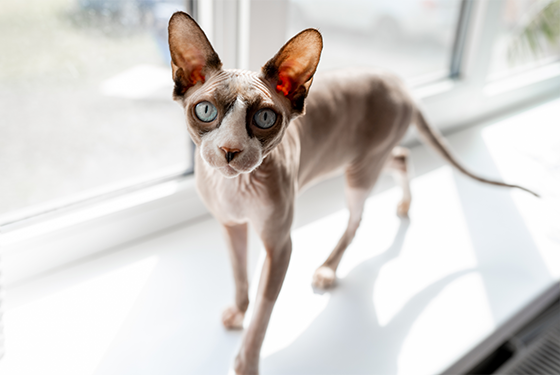
Keeping and caring for a Sphynx cat
Although Sphynx cats do not have fur to keep them warm, this is usually not a problem, because cat owners do no tend to keep their homes on the cool side. As long as the room temperature is pleasant even in winter, Sphynx cats will be quite content. A cosy cat bed can be positioned near a radiator during the colder months. Cuddly caves and blankets are also popular, as is a cat tree with surfaces to lie on. Not only can the cat file its claws on the cat tree, but it will also have a perfect view of what its two-legged friends are up to. The Sphynx cat is very open-minded towards humans, and this also applies to children.
Sphynx cats love contact with their humans, especially if they live in a single-cat household. However, it is even better if they have another cat as a companion, because hairless breeds are not usually allowed outside, resulting in a complete lack of social contact. Perhaps you can provide your pet with a cat-proof balcony. The inquisitive sphynx cat loves to spend time in such a place. It is, however, important to ensure that it is not exposed to too much sun, because it could easily get sunburnt.
Grooming is not an issue with the Sphynx cat, because they have no fur. Hairless cats do, however, need some skin care. Some owners occasionally shower their cats, but it is usually sufficient to rub them down with a damp cloth every now and then. This will remove any excess oil from the skin.
Nutrition
Whether it’s a kitten, an adult cat or a senior – the food for a Sphynx cat should always be of high quality and tailored to its age. Cats are carnivores by nature, so cat food should always contain a high proportion of meaty ingredients. Sugar, flavour enhancers and artificial colourings and preservatives do not belong in the food.
animonda has the ideal food for every stage of your cat’s life. You can choose between kitten, adult and senior cat food. The products are specially formulated to meet the specific nutritional requirements of the different life stages of cats. This provides the best foundation for your pet to enjoy a long and healthy life.
Health of the Sphynx cat
Sphynx cats are generally no more susceptible to illnesses than most other breeds. They are descended from normal domestic cats, which are known for their strong immune systems. However, the limited population of this breed has meant that health problems can occur as a result of inbreeding. This can result in a weakened immune system and make the cats more susceptible to disease. To help minimise this risk, hairless cats should only be purchased from responsible, trustworthy breeders.
Particular attention should be paid to the whiskers of hairless cats. These must under no circumstances be broken or absent, because this impairs the cat’s sensory perception. In Germany, for example, this is regarded as torture breeding, which is why special criteria are stipulated for the Sphynx cat in this respect. In addition, the wrinkles should not be so excessive that the cat is no longer able to clean all areas of its skin. This can lead to eczema and inflammation.
As with all breeds of cat, hereditary diseases can occur in both the Don Sphynx and the Canadian Sphynx. These include hypertrophic cardiomyopathy (HCM). This is the most common heart disease in cats. If detected at an early stage and treated with appropriate medication, cats with HCM can live for many years.
History and breeding
Our genes are what make us who we are. This is true not only for ourselves, but also for all animals. However, unplanned but nevertheless natural mutations do occur from time to time. In principle, this is a genetic defect that can have a wide variety of effects. In the case of hairless cats, it concerns hair growth. The Canadian Sphynx first appeared in 1966. The owners of a normal domestic cat discovered a hairless male in the litter. They decided to mate little “Prune” with his mother as soon as he reached adulthood. This resulted in seven kittens, two of which were hairless. It was with these that the pure breeding of this new type of cat began.
A similar situation occurred 20 years later, this time not in Canada, but in Russia – in Rostov-on-Don to be precise. Here, too, a male kitten with very little hair was discovered in a litter, and was later mated with his mother. Interestingly, the result was even better than with the Canadian Sphynx: all of the offspring had hardly any fur, which indicated that this was a dominant (and not a recessive or background) mutation. Because of the various mutations, it was clear that crossbreeding to add some fresh blood would not be advisable. Instead, they concentrated on pure breeding with their cats’ own offspring.
Both breeds have since been recognised by various associations. The Canadian Sphynx received its official recognition by the American cat association TICA in 1979, while the Don Sphynx was recognised by the European governing body FIFe in 2011.
You may also like this
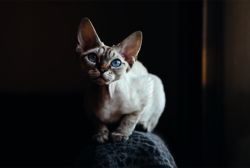
Devon Rex
Their thin and curly hair make the breed particularly
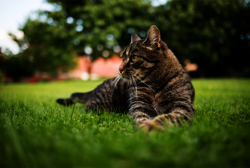
European Shorthair
Our pet cats also have a lot to offer
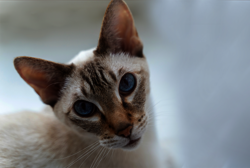
Oriental Shorthair
The Oriental Shorthair evolved from the Siamese cat
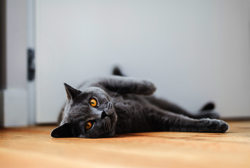
British shorthair
The breed originated from the domestic cat, it is calm and…
